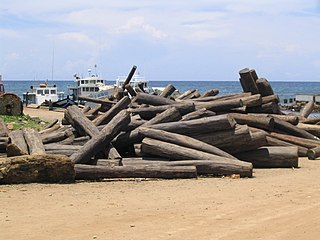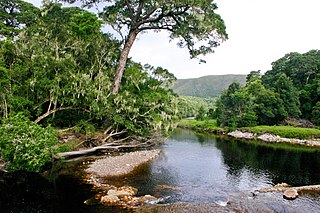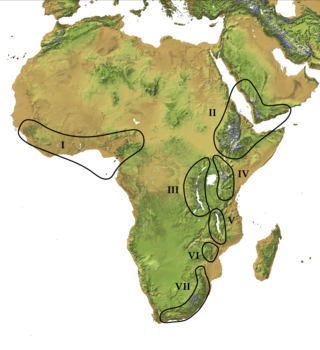
Lauraceae, or the laurels, is a plant family that includes the true laurel and its closest relatives. This family comprises about 2850 known species in about 45 genera worldwide. They are dicotyledons, and occur mainly in warm temperate and tropical regions, especially Southeast Asia and South America. Many are aromatic evergreen trees or shrubs, but some, such as Sassafras, are deciduous, or include both deciduous and evergreen trees and shrubs, especially in tropical and temperate climates. The genus Cassytha is unique in the Lauraceae in that its members are parasitic vines. Most laurels are highly poisonous.

Curtisia dentata is a flowering tree from Southern Africa. It is the sole species in genus Curtisia, which was originally classed as a type of "dogwood" (Cornaceae), but is now placed in its own unique family Curtisiaceae.

Umbellularia californica is a large hardwood tree native to coastal forests and the Sierra foothills of California, and to coastal forests extending into Oregon. It is endemic to the California Floristic Province. It is the sole species in the genus Umbellularia.

Illegal logging is the harvest, transportation, purchase, or sale of timber in violation of laws. The harvesting procedure itself may be illegal, including using corrupt means to gain access to forests; extraction without permission, or from a protected area; the cutting down of protected species; or the extraction of timber in excess of agreed limits. Illegal logging is a driving force for a number of environmental issues such as deforestation, soil erosion and biodiversity loss which can drive larger-scale environmental crises such as climate change and other forms of environmental degradation.

Laurel forest, also called laurisilva or laurissilva, is a type of subtropical forest found in areas with high humidity and relatively stable, mild temperatures. The forest is characterized by broadleaf tree species with evergreen, glossy and elongated leaves, known as "laurophyll" or "lauroid". Plants from the laurel family (Lauraceae) may or may not be present, depending on the location.

Ocotea is a genus of flowering plants belonging to the family Lauraceae. Many are evergreen trees with lauroid leaves.
Stinkwood, german Stinkholz, french Bois Puant, is the common name for a number of trees or shrubs which have wood or plant parts with an unpleasant odour, including:
Kuloa usambarensis is a species of tree in the laurel family (Lauraceae). It is native to eastern Africa in Kenya, Tanga Region of Tanzania, and locally in Uganda, where it occurs at 1600–2600 m elevation in high rainfall Afromontane cloud forest. Common names include East African camphorwood, mkulo (Tanzania), mwiha (Uganda), muwong, muzaiti, and maasi.

The Knysna–Amatole montane forests ecoregion, of the tropical and subtropical moist broadleaf forests biome, is in South Africa. It covers an Afromontane area of 3,100 square kilometres (1,200 sq mi) in the Eastern Cape and Western Cape provinces.

The Afromontane regions are subregions of the Afrotropical realm, one of the Earth's eight biogeographic realms, covering the plant and animal species found in the mountains of Africa and the southern Arabian Peninsula. The Afromontane regions of Africa are discontinuous, separated from each other by lower-lying areas, and are sometimes referred to as the Afromontane archipelago, as their distribution is analogous to a series of sky islands.

Afrocarpus falcatus is a species of tree in the family Podocarpaceae. It is native to the montane forests of southern Africa, where it is distributed in Malawi, Mozambique, South Africa, and Eswatini. Common names include common yellowwood, bastard yellowwood, outeniqua yellowwood, African pine tree, weeping yew, Afrikaans: outeniekwageelhout, kalander, Sotho: mogôbagôba, Xhosa: umkhoba and Zulu: umsonti. It is widespread, in some areas abundant, and not considered threatened, but it is a protected tree in South Africa. It is grown as an ornamental tree, especially in South Africa, and occasionally abroad.
The following outline is provided as an overview of and guide to forestry:

Newlands Forest is a conservancy area on the eastern slopes of Table Mountain, beside the suburb of Newlands, Cape Town, South Africa. It is owned and maintained by the Table Mountain National Parks Board, along with the City Parks Department of Cape Town, and includes a Fire Station, Nursery and Reservoir.

Celtis africana, the white stinkwood, is a deciduous tree in the family Cannabaceae. Its habit ranges from a tall tree in forest to a medium-sized tree in bushveld and open country, and a shrub on rocky soil. It occurs in Yemen and Somaliland and over large parts of Africa south of the Sahara. It is a common tree in the south and east of southern Africa, where the odour given off by freshly-cut green timber is similar to that of Ocotea bullata or black stinkwood.

Areas of forest which grow in KwaZulu-Natal, South Africa mostly on south facing slopes in higher rainfall areas, and along the humid coastal areas. Different types of forest can be identified by their species composition which depends mostly on the altitude, latitude and substrate in which they grow. South facing slopes are favourable for the development of forest as they are more shaded, and therefore cooler and retain more moisture than the northern slopes. The extra moisture on the south slopes is not only favoured by forest trees, but also helps to prevent or subdue wildfires. Fires can also be blocked by cliff faces and rocks or boulders on these slopes, and by streams or rivers at the base of the slopes. The coastal regions are conducive to forest formation, because of high rainfall and humidity which are favoured by forest trees and also help to prevent or subdue fires. The rivers of the coastal areas are also broader than further inland, which may often prevent fires from spreading long distances, and fires generally burn uphill and therefore more often away from areas at low altitude.

The Karkloof Forest is situated in the Karkloof Nature Reserve, 22 km north of Howick, KwaZulu-Natal, South Africa.

Sideroxylon inerme is a southern and eastern African coastal tree, with dense foliage, black berries and small, foetid, greenish flowers. The tree's generic name means "Iron-wood" in Greek, referring to its very hard timber.

Southern Afrotemperate Forest is a kind of tall, shady, multilayered indigenous South African forest. This is the main forest-type in the south-western part of South Africa, naturally extending from the Cape Peninsula in the west, as far as Port Elizabeth in the east. In this range, it usually occurs in small forest pockets, surrounded by fynbos vegetation.

Afzelia quanzensis is a species of tree native to sub-Saharan Africa. It ranges from Somalia and Democratic Republic of the Congo to South Africa. It is a protected tree in South Africa.
This article deals with forest conservation in South Africa.


















